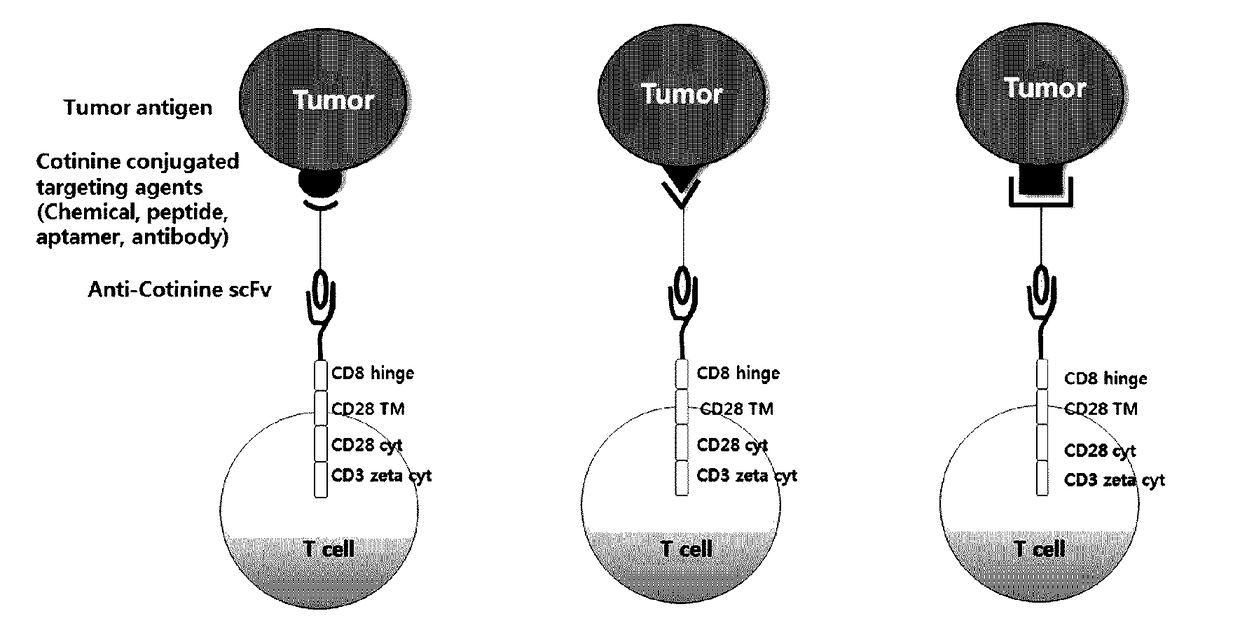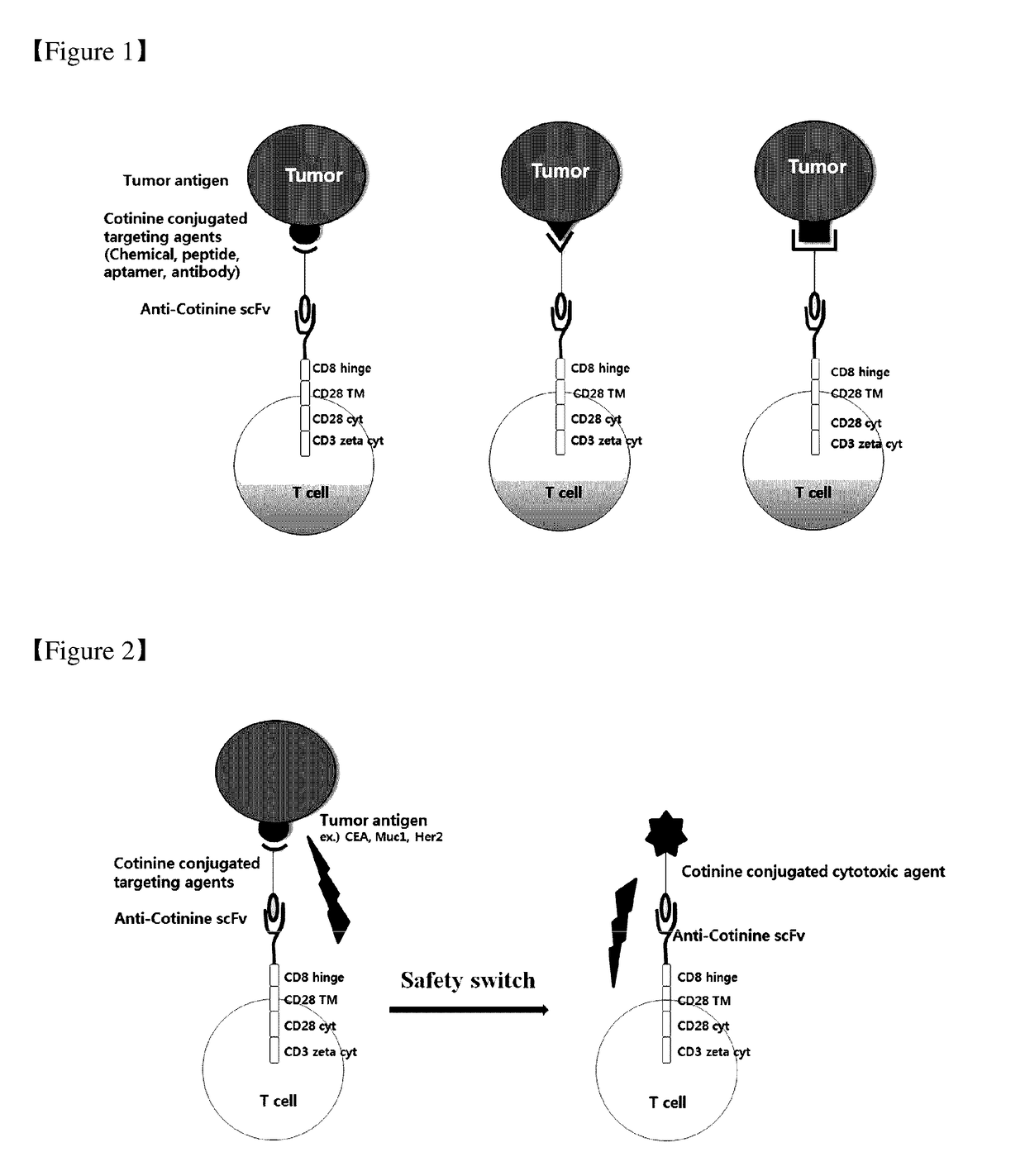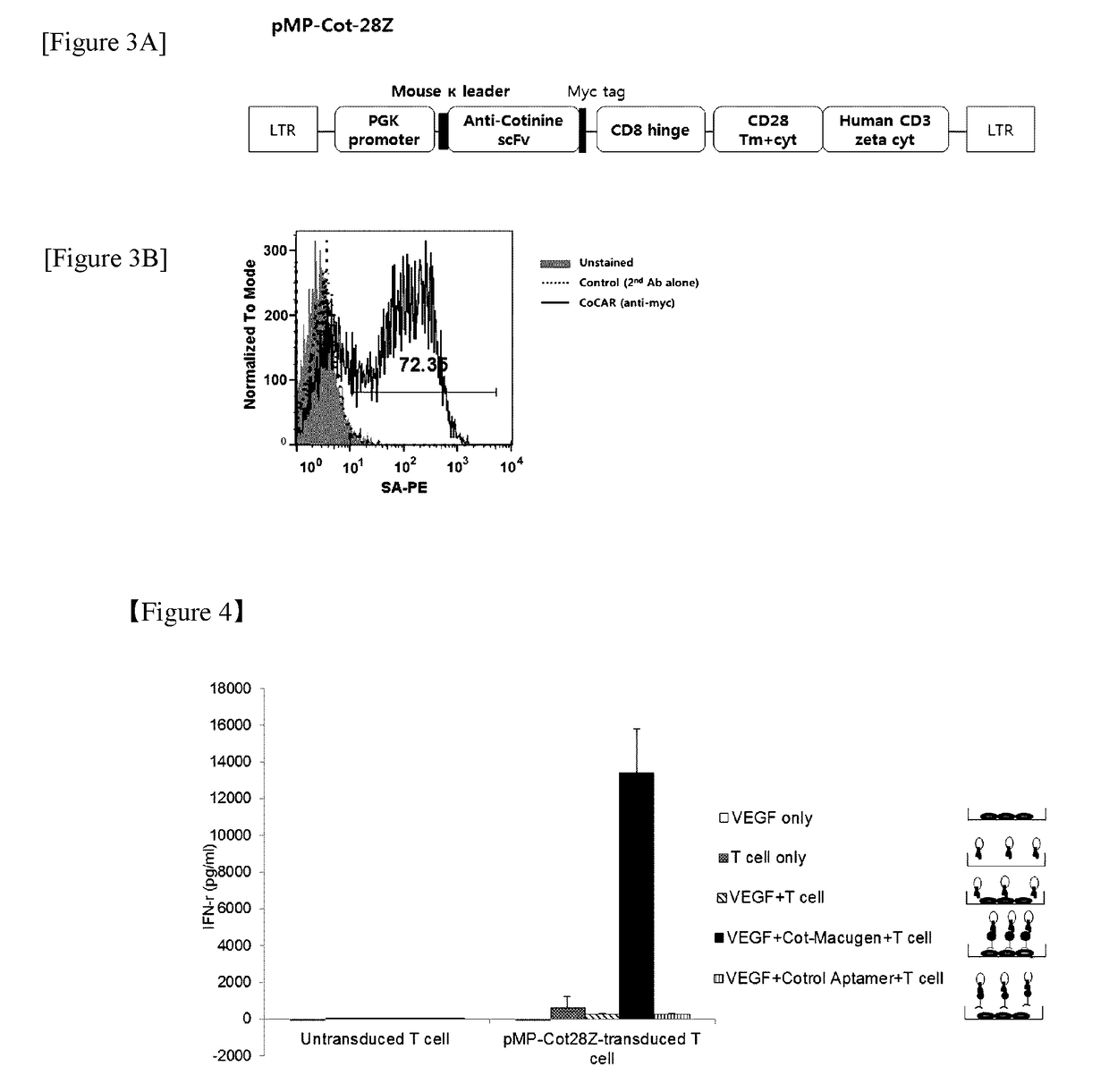Chimeric antigen receptor to which Anti-cotinine antibody is linked, and use thereof
a technology of chimeric antigen receptor and anticotinine antibody, which is applied in the direction of immunoglobulins, peptides, drugs/humans, etc., can solve the problems of short in vivo half-live, limitation of optimization conditions, and molecules with the disadvantage of no or weak cytotoxicity, etc., to suppress adverse immune side effects and induce cells
- Summary
- Abstract
- Description
- Claims
- Application Information
AI Technical Summary
Benefits of technology
Problems solved by technology
Method used
Image
Examples
example 1
on of Retrovirus Comprising Nucleic Acid Encoding Chimeric Antigen Receptor Linked with Anti-Cotinine Antibody Fragment
[0085]1-1. Preparation of Construct
[0086]First, a plasmid comprising nucleic acids each encoding an scFv fragment of an anti-cotinine antibody, a hinge domain, a transmembrane domain, and a signal transduction domain was prepared by the following method.
[0087]Specifically, a scFv fragment of an anti-cotinine antibody was amplified by PCR in a conventional manner from a template plasmid using a primer including a mouse Ig kappa leader sequence. The template was a plasmid generated by ligation of an anti-cotinine scFv fragment cleaved with the SfiI restriction enzyme to a pCEP4 vector (Invitrogen, US) (Clin. Chim. Acta., 2010, 411-1238). Meanwhile, the skeletal part of the chimeric antigen receptor including c-myc tag, human CD8 hinge region, transmembrane region and cytoplasmic region of mouse CD28, and a cytoplasmic region of human CD3 zeta, was amplified by PCR fro...
example 2
on of Cytotoxic T Cells with a Chimeric Antigen Receptor Linked with Anti-Cotinine Antibody Fragment Presented on Surface Thereof
[0091]Using the virus prepared in Example 1-2, cytotoxic T cells were prepared with a chimeric antigen receptor linked with anti-cotinine antibody fragment presented on the surface thereof.
[0092]First, splenocytes were isolated from B6 mice and dispensed in a cell culture container coated with 10 μg / mL of the anti-CD3 antibody (145-2C11, BD Bioscience, US) so that there were 2.5×106 cells per well. The cells were supplemented with a total of 1 mL of the RPMI-1640 medium including 2 μg / mL of the anti-CD28 antibody (37.51, BD Bioscience, US), and cultured under conditions of 5% CO2 and 37° C. After 24 hours, 1 mL of the concentrated retrovirus including 2 μL of polybrene (Sigma-Aldrich, US) at 6 mg / mL was added to the cells and transduced by centrifugation for 90 minutes at 2,500 rpm using a centrifuge (Centrifuge 5810R, Eppendorf, US). Polybrene was used to...
example 3
on of Complex of Cotinine and Binding Molecule
[0094]3-1. Preparation of Complex of Cotinine and Antibody
[0095]As a binding molecule, cotinine-conjugates were prepared using rituximab (Genentech, Biogen, US), which is an anti-CD20 antibody, trastuzumab (Genentech, US), which is an anti-HER2 antibody, CT302 (Celltrion, Korea), which is an anti-influenza virus hemagglutinin antibody, and W6 / 32 (eBioscience, US), which is an anti-HLA antibody. Cotinine conjugation was performed by an EDC (1-ethyl-3-[3-dimethylaminopropyl]carbodiimide) coupling method.
[0096]First, the antibodies above were dissolved in PBS to a concentration of 25 μM. Meanwhile, trans-4-cotinine carboxylic acid (Sigma-Aldrich) was dissolved in 1 mL of the MES buffer [0.1 M MES (2-[morpholino]ethanesulfonic acid) and 0.5 M sodium chloride, pH 6.0] to a concentration of 5 mM. EDC at a concentration of 50 mM and N-hydroxysulfosuccinimide (Sulfo-NHS, Thermo Scientific, US) at a concentration of 125 mM were added to the solut...
PUM
| Property | Measurement | Unit |
|---|---|---|
| Cell death | aaaaa | aaaaa |
| Cytotoxicity | aaaaa | aaaaa |
Abstract
Description
Claims
Application Information
 Login to View More
Login to View More - R&D
- Intellectual Property
- Life Sciences
- Materials
- Tech Scout
- Unparalleled Data Quality
- Higher Quality Content
- 60% Fewer Hallucinations
Browse by: Latest US Patents, China's latest patents, Technical Efficacy Thesaurus, Application Domain, Technology Topic, Popular Technical Reports.
© 2025 PatSnap. All rights reserved.Legal|Privacy policy|Modern Slavery Act Transparency Statement|Sitemap|About US| Contact US: help@patsnap.com



